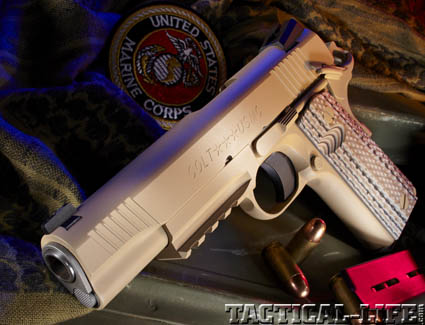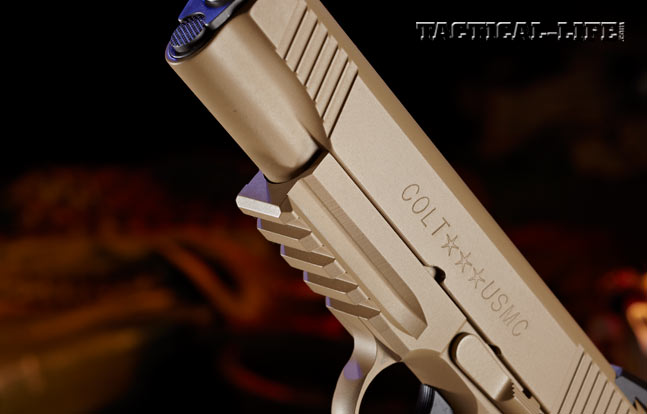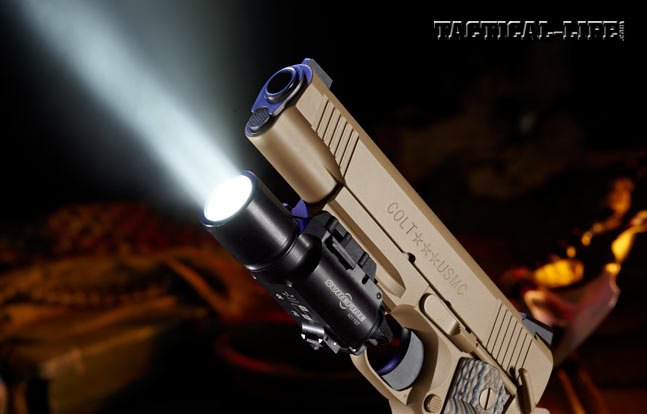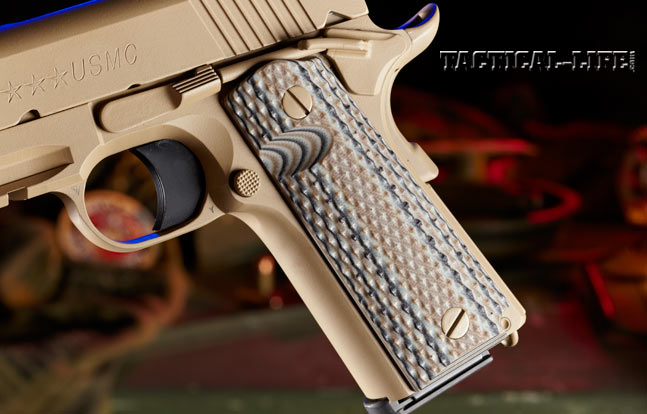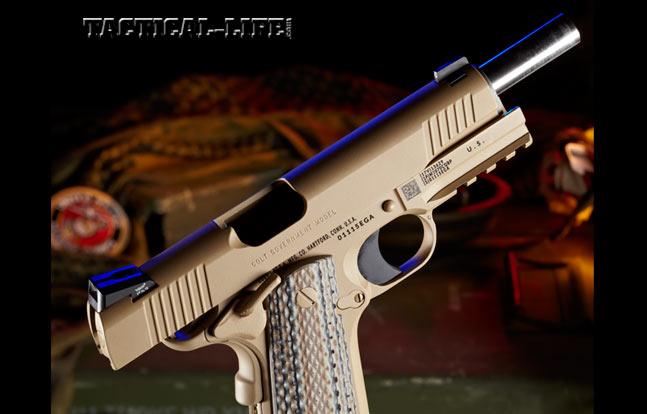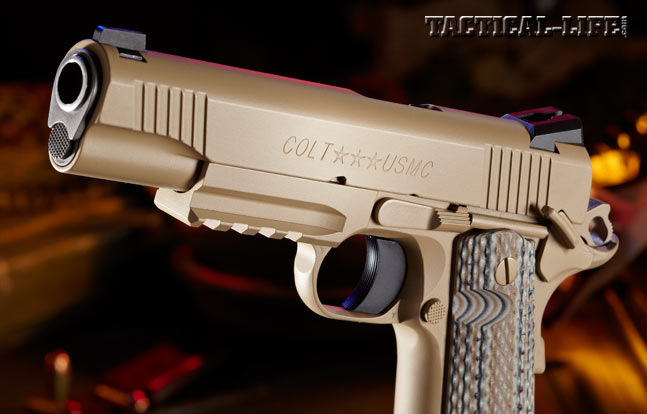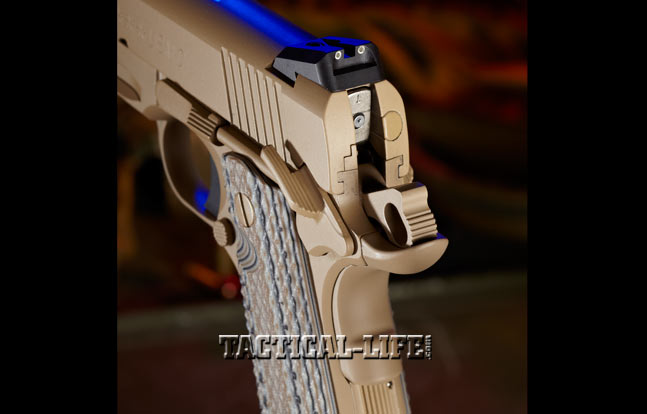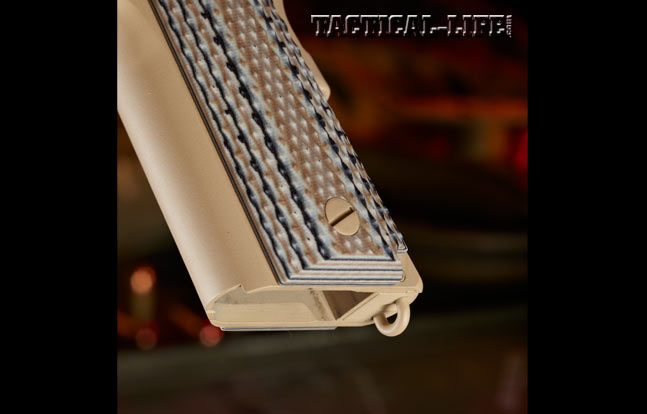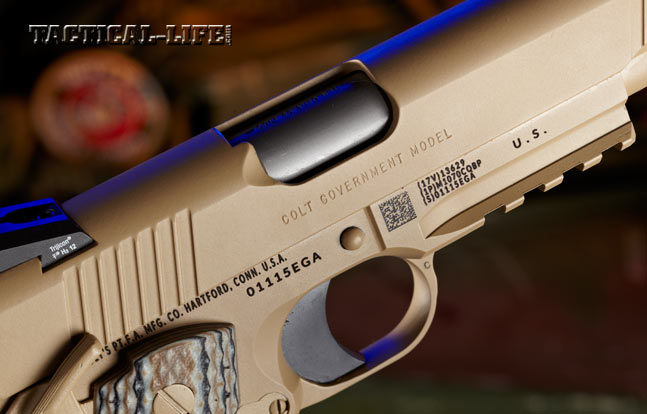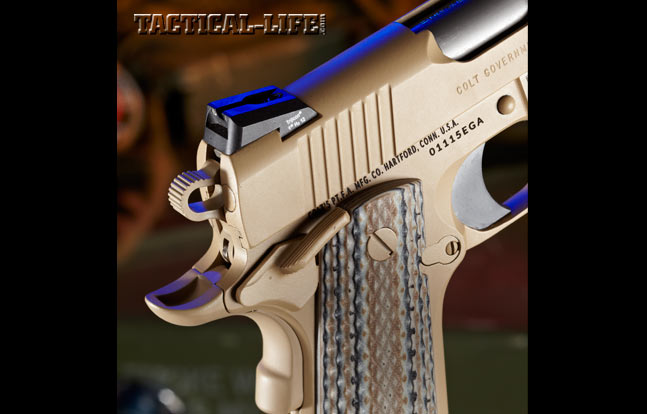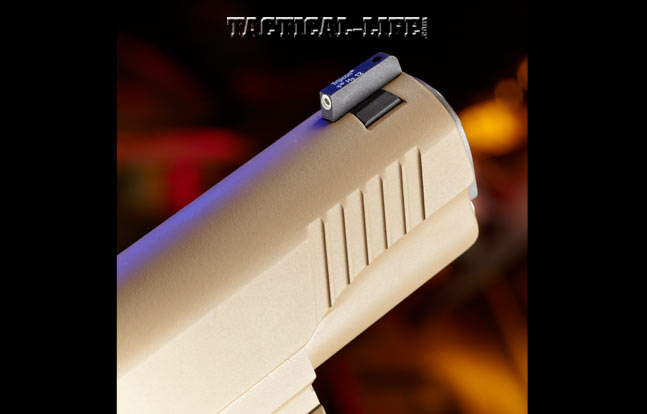The USMC Precision Weapons Section, in Quantico, Virginia, has been custom-building 1911s for the Marine Corp’s elite special operations and reconnaissance units since 1985, first as the .45 caliber MEUSOC Pistol and later as the .45 caliber M45 Close Quarter Battle Pistol (CQBP). The Marines use the M45 as a secondary weapon when conducting CQB operations.
“The pistol will see whatever environmental hell this world offers, whether the gun’s dropped in sand, caked with mud, dunked in salt water or driven over by trucks…”
The M45 was built with parts taken from in-stock M1911A1 pistols and other commercial parts. It’s a testament to the 1911’s design and durability as well as to special operators’ preference for the weapon. But there came a point when demand exceeded supply. In March 2010 the Marine Corps Systems Command issued a formal request for a pistol that would satisfy the demand.
In the official Request For Proposal (RFP) the Marine’s stated that “the pistol’s operating environment is characterized by high usage in training, rough handling and environments on deployments, and limited access to repair and maintenance resources during high-tempo operations.” Translated, that means the pistol will see whatever environmental hell this world offers, whether the gun’s dropped in sand, caked with mud, dunked in salt water or driven over by trucks. Also, there will be no time for cleaning or repairs. So the bottom line is that it needs to work all of the time and anywhere. The RFP did not specifically request a 1911 platform but a “semi-automatic pistol in .45 ACP using a single-stack magazine that must hold at least seven rounds.” Furthermore, the RFP stated it would be desirable if the pistol would “function with the Marine Corps .45 ACP seven-round magazine (NSN 1005-01-373-2774) used in the current MEUSOC pistol.” That magazine only fits a 1911-style pistol, so it was obvious what kind of gun the Marines were looking for.
Advertisement — Continue Reading Below
Other requirements for the pistol included the following: (1) It locked the slide or bolt to the rear after the last round in the magazine was fired; (2) it had a beveled magazine well to facilitate rapid loading; (3) it was 9 inches long and under 4.5 pounds; (4) it had demonstrable drop-in parts interchangeability, with no milling, filing or fitting required and with no degradation in performance after parts were exchanged; (5) it was resistant to corrosion and chemicals; (6) it was compatible with current military-approved small-arms cleaning, lubrication, and preservative and storage agents; and (7) it was a commercial-off-the-shelf pistol.
Numerous 1911 manufacturers—the usual suspects like Kimber, Colt, Springfield Armory and some lesser-known manufacturers like Karl Lippard—competed for the contract. Then in July 2012, a $22.5 million contract for an indefinite-delivery/indefinite-quantity of M45A1 CQBPs was awarded to Colt Defense for production, delivery and logistical support. Colt Defense, the defense contracting arm of Colt, had submitted an enhanced version of Colt’s Manufacturing’s Rail Gun, model O1980RG.

Gun Details
Advertisement — Continue Reading Below
The M45A1 CQBP is manufactured from forged stainless steel just like the Colt Rail Gun. The receiver, slide, slide stop and barrel go through a forging process to make the steel stronger and tougher as well as to hold tolerances more closely. The barrel is match grade. The finishing spec specified dull, non-reflective surfaces and use of standard military colors, so the M45A1 wears a desert tan Cerakote finish over markings that clearly indicate the end user. “Colt USMC” is roll-stamped on the left side of the slide; on the right is “Colt Government Model.” The pistol also wears a unique identification (UID) label on the receiver. Similar to a barcode, the UID is basically a serial number that comprises a 2-D matrix symbol containing data that can be deciphered by a reader. Since 2005, all DoD equipment wear UIDs.
“Only three components on the M45A1 are non-Colt manufactured parts: the G10 grips, the Novak three-dot, tritium night sights and the Wilson Combat seven-shot magazine…”
Colt chose the Rail Gun as a basis for the M45A1 since one of the requisites called for an accessory rail that met Mil-Std-1913 specifications to mount accessories. The rail needed to be a true Picatinny rail—not a lookalike—which has more actual surface area for an accessory to grasp onto than, say, a Weaver-style rail. That extra surface area makes the mountings more reliable in extreme environments.
In hand, the M45A1 felt comfortable and the rail gave the weapon slightly more heft than a Government Model 1911. The ambidextrous safety worked crisply when I used either shooting hand. Specifications called for an upswept grip safety and an ambidextrous manual safety, which are operable by thumb by a user wearing cold weather and NBC gloves. The M45A1’s upswept beavertail grip safety has a prominent bump, ensuring the safety can be engaged while slightly lowering the centerline of the bore in hand and protecting the web of my hand. I operated the M45A1 with and without winter gloves and had no issues. (I did not have any chemical gloves available for testing.) The lightweight, enhanced hammer sported serrations that provided enough grasp to easily cock the hammer, while the sides of the hammer were easy to grasp and hold when I pulled the trigger to lower it.
Advertisement — Continue Reading Below
The M45A1’s grooved, long, solid trigger and the flat mainspring housing are similar to those of original-issue 1911s. World War II–era 1911A1s changed the setup with a short trigger and arched mainspring housing in an effort to help GIs shoot higher. Shooting styles have changed over the years but have come full circle with the M45A1. The trigger is spec’d out to 5 pounds and measures 5.3 pounds on average. A trigger with a pull of that weight is fine considering this pistol’s intended purpose. The M45A1 does utilize the Series 80 trigger system, which has an internal firing-pin safety that is actuated via the trigger. (That firing-pin safety was a requirement for the M45 replacement.)
The G10 grips are gritty without feeling like they are hanging onto my hand, rather than vice versa. The grips are slightly thicker than the traditional flatter, double-diamond checkered walnut or the plastic grips of a 1911A1. My hand is of average size, so smaller-handed users may feel a bit of girth with the M45A1’s grips. There’s also a lanyard loop in the mainspring housing per spec. The magazines have a metal basepad so that when you slam a magazine home the lanyard loop doesn’t jam your palm. Only three components on the M45A1 are non-Colt manufactured parts: the G10 grips, the Novak three-dot, tritium night sights and the Wilson Combat seven-shot magazine.

Novak three-dot Trijicon night sights are simple and fast to acquire targets in low-light or at night with their three green, glowing dots. The sights are easily activated by exposing them to sunlight or artificial light like a flashlight’s. The sights are snag-free and rugged and provided an excellent sight picture. The front sight is drift-adjustable for windage, and the rear sight is held in its dovetail via a hex screw and also adjusts for windage. I found it easy to rack the slide against a surface or against gear, which may become necessary when one arm is out of commission. I liked the large, angled slide serrations in the rear and near the muzzle. They allowed for good purchase barehanded and with gloves. The ejection port was angled and flared.
Advertisement — Continue Reading Below
The 7-shot Wilson Combat magazine seemed to be missing an eighth round, but the USMC stuck with this magazine capacity because the 1911 pistol magazine was originally designed for a 7-shot magazine and the 7-shot magazines have battle-proven reliability. The Wilson magazine has a nylon follower that is self-lubricating and does not corrode. The metal basepad gave the magazine just enough length so the user doesn’t jab his or her palm on the lanyard loop when slamming it home. The beveled edges in the magazine well—also a spec—facilitated quick magazine reloads.
“The M45A1 CQBP was built and spec’d respectively by two entities with over 100 years of experience in the 1911 platform…”
I used a variety of ammo to test the M45A1, though in military hands it will mostly only use 230-grain FMJ or ball ammunition. Since the pistol was designed to spec to perform, I loaded Federal Eagle 230-grain FMJ, Winchester 230-grain BEB (brass enclosed base) and a handload using a 185-grain SWC in the first magazine. At 15 yards the M45A1 operated without incident. I could feel the difference between the faster handload and the factory loads, but the M45A1 had no preference at close range. The recoil of the M45A1 was also softer thanks to Colt’s wisely opting for a dual recoil-spring system designed to reduce recoil and prevent frame battering. This is a similar setup Colt uses in its 1911 Delta Elite chambered in 10mm, where two recoil springs are nested together. At close range and using Darktonic zombie targets, I fired for speed using an assortment of magazines, some from Springfield Armory and Chip McCormick, with no malfunctions. The thick front sight allowed me to efficiently align it in the gaping rear sight and keep the holes nicely clustered. I liked the long trigger and flat mainspring housing, and the trigger broke cleanly, even for a Series 80 trigger. Unfortunately, or rather unfairly, my benchmark for a 1911 trigger is a 3.5-pound Series 70. The M45A1’s is not made for precision work, but it will shoot the black out of a target.
At 25 yards and from a rest, I fired the M45A1 for accuracy. Per spec, it needs to hold a five-shot group to an average not exceeding 4 by 4 inches at 25 yards. The results met my expectations as well as the Marines’, I assume. I averaged slightly over 2 inches with the 230-grain ammunition. The M45A1 did not particularly like my reload, but with an average group size under 3 inches I am not complaining. I ran boxes of factory ammunition and containers of reloads through the M45A1, and it demonstrated it could exceed the requirement of an average minimum of 300 rounds between stoppages. I have no reservations that the pistol will exceed the minimum 5,000 rounds between parts failures.
Advertisement — Continue Reading Below
I didn’t immerse the M45A1 in jet fuel or DDT, nor operate it in -25°F to 120°F temperatures as the military had done according to my sources. The actual test results are classified, but we do know that the Colt gun and those of the competitors were put through a 15,000-round test. (The original 1911 went through a 6,000-round test.) Using government ammunition, which loads a 230-grain FMJ bullet to 850 feet per second (fps), the military’s test consisted of 14 to 20 rounds per minute with the pistol air-cooled after every 10 magazines and cleaned every 300 rounds. The pistol was intermittently stripped down for a visual inspection of internal components, and 50 percent of the testing was done using an accessory on the rail.
The M45A1 strips down just like all Government 1911s were meant to—without the use of tools. There is no need for a hex wrench to disassemble a recoil rod. nor is a bushing wrench required to rotate the bushing like with some newer 1911s. The maintenance manual will be developed by the military with Colt’s input, and it won’t change much from manuals printed in 1911. If anything, preventative maintenance suggests replacing the recoil springs every 5,000 to 7,000 rounds and checking the extractor. Like most military 1911s it will run dirty and nearly forever.
Final Notes
Advertisement — Continue Reading Below
The M45A1 CQBP was built and spec’d respectively by two entities with over 100 years of experience in the 1911 platform. The military connection runs deep with this Colt-manufactured and -enhanced 1911. It’s a combat-ready pistol that will shoot the black out all day long.
For more information, visit coltsmfg.com or call 800-962-2658.
